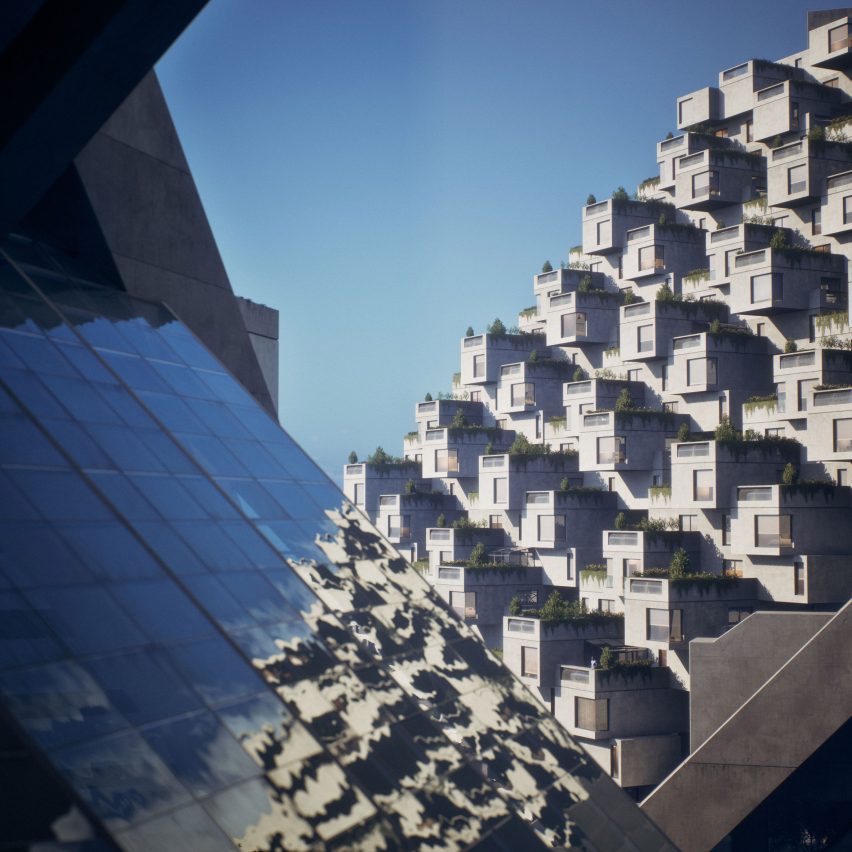
Epic Games creates virtual model of Moshe Safdie’s unrealized Habitat 67
[ad_1]
Software developer Epic Games and visualisation firm Neoscape have created an interactive virtual model of architect Moshe Safdie’s Habitat 67 in Montreal, a housing complex that was constructed for the World’s Fair.
Epic Games and Neoscape used original plans for Habitat 67 to test new visualisation methods made possible by the latest version of Epic Game’s Unreal Engine, a 3D graphics game engine.
Using materials from Safdie’s studio – Safdie Architects – the team was able to construct a virtual version of the project as it was intended, which includes a larger complex with massive arches holding rows of cubic apartments similar to Habitat 67’s existing configuration.

“This was an opportunity to actually go, not quite into the building, but to experience it in a way that I could not have imagined when I designed it,” Safdie told Dezeen.
“And here it is. 60 years since I designed it, it seems as fresh and relevant to me as then, if not more,” he continued, noting that he has always been disappointed that the whole schema for the complex was not approved for the initial construction.
“One thought that went through my mind was if I had this tool and I could have shown this to the federal cabinet in 1964, maybe that would have convinced them – that was my reaction.”

The virtual rendering of the building shows the full height of the structure on location in Montreal.
The team used drone footage of the actual site, plans and consultations with engineers to make the model seem as real as possible, and the video game technology allows users to move in and out of the arches, similar to playing a video game.

The drone footage and spatial scans allowed the designers to import not only the structure’s form but also its materiality.
Neoscape, which has been creating visualisations for Safdie for decades, worked with Epic Games to create a number of deliverables, including video walk-throughs of the project as well as an editable file that will allow users to make changes to the rendering.

“This is kind of like a curated experience,” Epic Games product specialist Carlos Cristerna told Dezeen.
“And then what when will release these and then people will have also the ability to download all of the source files. So they will be able to explore that there.”

The program allow for different lighting conditions so that users and designers can see the project as it would look during different times of day.
The team added that in the future, weather conditions could also be added to give viewers an idea of the way that the elements like snow and rain may affect the structure.

While the project has a historical and educational aspect, the team believes that the methodology could be useful for architects in expressing more fully-realised projects to clients and to understanding how a building would appear if built, a sentiment that Safdie echoed.
However, Safdie noted that the time and costs of the process may not make sense for every project, but he hopes that, having now seen the project at scale, he may someday be able to see it built.
“My reaction was I gotta get this built before I go,” he said. “That will be amazing.”
The product comes after an explosion of architectural renderings created for things like technology company Meta’s Metaverse, a scheme that hopes to create a 3D world where users can socialise in digitally fabricated environments.
Safdie said he was sceptical about the idea of the virtual world being a place to replace real-life interaction and that technology like this should be used to realising actual projects.

Since the completion of Habitat 67, Safdie has completed a number of large-scale projects including the massive skyscraper complex in Chongqing, China called Raffles City, which features a “horizontal” skyscraper supported by other structures on the site.
Other forays into visualising unbuilt projects include Spanish architect David Romero’s renderings of buildings designed by American architect Frank Lloyd Wright.
[ad_2]





